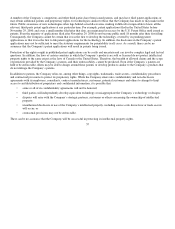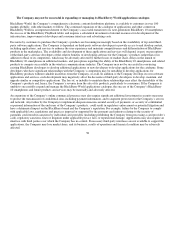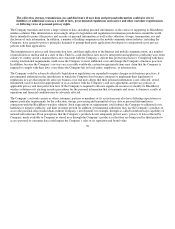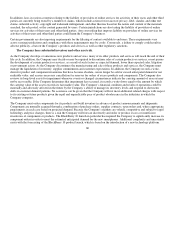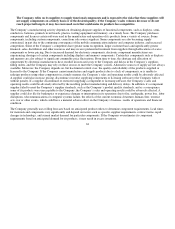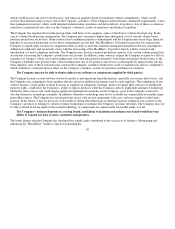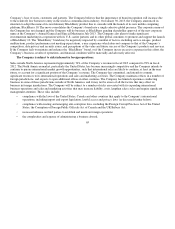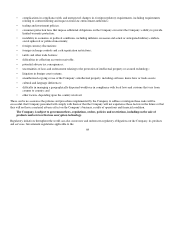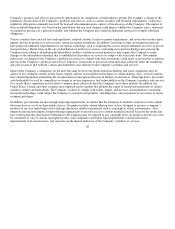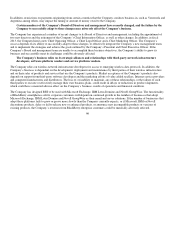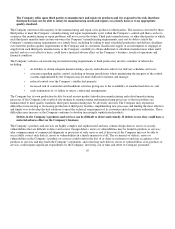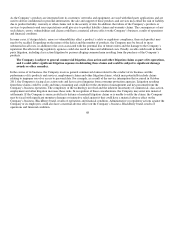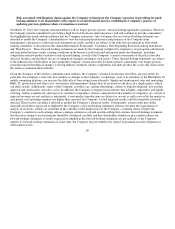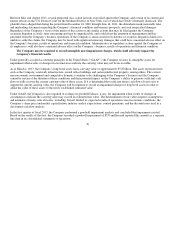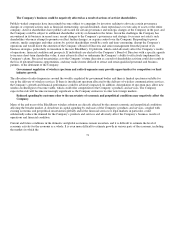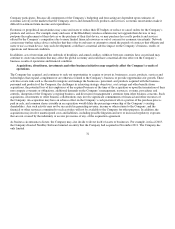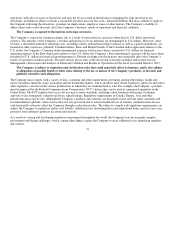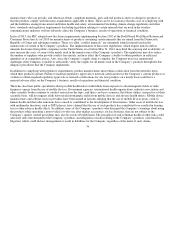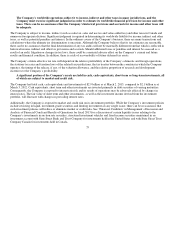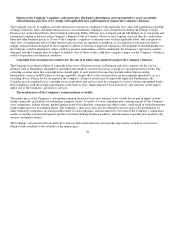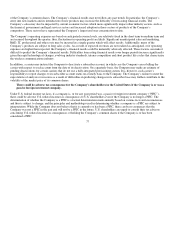Blackberry 2013 Annual Report Download - page 74
Download and view the complete annual report
Please find page 74 of the 2013 Blackberry annual report below. You can navigate through the pages in the report by either clicking on the pages listed below, or by using the keyword search tool below to find specific information within the annual report.
The Company relies upon third parties to manufacture and repair its products and it is exposed to the risk that these
third parties may not be able to satisfy its manufacturing needs and repairs on a timely basis or to an appropriate
quality standard.
The Company outsources the majority of the manufacturing and repair of its products to third parties. The resources devoted by these
third parties to meet the Company’s manufacturing and repair requirements is not within the Company’s control and there can be no
assurance that manufacturing or repair problems will not occur in the future. Third party manufacturers, or other third parties to which
such third party manufacturers in turn outsource the Company’s manufacturing requirements, may not be able to satisfy the
Company’s manufacturing requirements on a timely basis, including by failing to meet scheduled production and delivery deadlines
or to meet the product quality requirements of the Company and its customers. Insufficient supply or an interruption or stoppage of
supply from such third party manufacturers or the Company’s inability to obtain additional or substitute manufacturers when and if
needed, and on a cost-effective basis, could have a material adverse effect on the Company’s business, results of operations and
financial condition.
The Company’s reliance on outsourcing its manufacturing requirements to third parties may involve a number of other risks,
including:
The Company has its own production facility focused on new product introduction manufacturing and related manufacturing
processes. If the Company fails to effectively manage its manufacturing and manufacturing processes so that its products are
manufactured to meet quality standards, third party manufacturing may be adversely affected. The Company may experience
difficulties in increasing or decreasing production at third party facilities, implementing new processes and finding the most effective
and timely way to develop the best solutions to meet the technical requirements of its customers and of regulatory authorities. These
difficulties may increase as the Company continues to develop increasingly sophisticated products.
Defects in the Company’s products and services can be difficult to detect and remedy. If defects occur, they could have a
material adverse effect on the Company’s business.
The Company’s products and services are highly complex and sophisticated and may contain design defects, errors or security
vulnerabilities that are difficult to detect and correct. Design defects, errors or vulnerabilities may be found in products or services
after commencement of commercial shipments or provision of such services and, if discovered, the Company may not be able to
successfully correct such defects, errors or vulnerabilities in a timely manner or at all. The occurrence of defects, errors or
vulnerabilities in the Company’s products or services could result in the loss of or delay in customer or end user acceptance of its
products or services and may harm the Company’s reputation, and correcting such defects, errors or vulnerabilities in its products or
services could require significant expenditures by the Company, involving cost or time and effort of Company personnel.
67
• an inabilit
y
to obtain ade
q
uate manufacturin
g
ca
p
acit
y
and reduced control over deliver
y
schedules and costs;
• concerns regarding quality control, including in foreign jurisdictions where maintaining the integrity of the control
s
y
stems im
p
lemented b
y
the Com
p
an
y
ma
y
be more difficult to monitor and mana
g
e;
• reduced control over the Com
p
an
y
’s intellectual
p
ro
p
ert
y
;
• increased risk of counterfeit and fraudulent activities
g
ivin
g
rise to the availabilit
y
of unauthorized devices; and
• earl
y
termination of, or failure to renew, contractual arran
g
ements.


